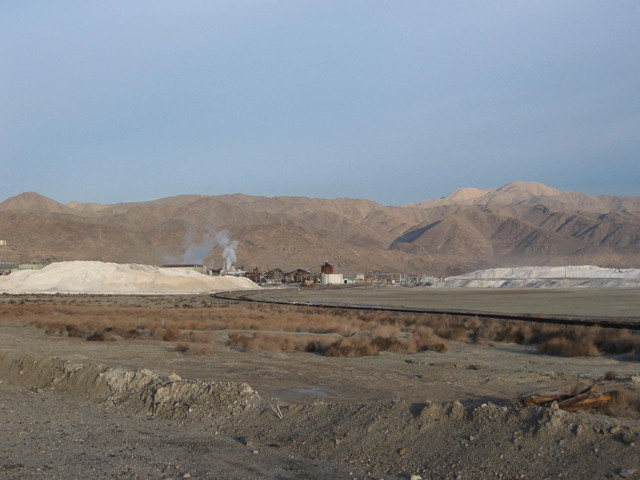
by U.S. Geological Survey Wednesday, June 13, 2018
Dennis S. Kostick, a mineral commodity specialist for the U.S. Geological Survey, compiled the following information on soda ash, one of the leading inorganic chemicals produced in the United States.

Six companies in the United States — four in Wyoming, one in California (shown below), and one in Colorado — produce soda ash. Credit: Bob Perry
Natural soda ash, sodium carbonate, is an alkali chemical refined from the mineral trona or from naturally occurring sodium carbonate-bearing brines. Synthetic soda ash is sodium carbonate that has been manufactured from one of several chemical processes. Whether natural or synthetic, soda ash is an essential raw material in the production of flat glass and fiberglass — both of which are used by the domestic automotive and construction industries. Soda ash is also used to produce chemicals, detergents and other important industrial products.
In 2011, soda ash ranked 10th on the list of domestic production of all chemicals, excluding petrochemical feedstocks. Although soda ash represented about 2 percent of the total estimated $74 billion U.S. nonfuel mineral industry, its use in many products contributes substantially to the gross domestic product of the United States. Soda ash production tends to increase with population and gross domestic product. Domestic soda ash consumption has been relatively flat for several years, increasing about 1 percent annually.
Natural sodium carbonate commonly occurs as a precipitate in shallow, nonmarine alkaline lakes and marshes and usually coexists with various chloride and sulfate salts. Because it is a soft and soluble mineral usually found in shallow bodies of water, sodium carbonate deposits are subject to destruction by natural mechanical and chemical erosion. Therefore, large economic sodium carbonate deposits are relatively rare; those that are found are usually geologically young, forming between the Eocene and Pleistocene.
There are five forms of sodium carbonate deposits, which, in terms of decreasing economic significance, are buried ore, surface or subsurface brines, crystalline shoreline or bottom crusts, shallow lake-bottom crusts, and surface efflorescences. Although more than 95 sodium carbonate deposits have been identified worldwide, the United States has the world’s largest deposit of buried trona in Green River, Wyo. — enough to sustain the domestic demand for soda ash for centuries. Only Botswana, China, Kenya and the United States produce soda ash from natural sources.
For more information on soda ash and other mineral resources, visit: minerals.usgs.gov/minerals.
Soda ash production and consumption
World production of natural and synthetic soda ash was estimated at 51.3 million metric tons in 2011.
Of the 29 countries that produce natural and synthetic soda ash, the United States is the world’s second-leading producer, accounting for 26 percent of total world output.
China, Germany, Russia, and the United States accounted for 76 percent of world soda ash production.
Reported consumption of soda ash in the U.S. was 5.15 million metric tons in 2011.
The U.S. exported a record high 5.47 million metric tons of soda ash in 2011.
Fun facts
The term soda ash originated from the burning and leaching of sodium-rich kelp and seaweed to produce a crude “soda ash.”
Early Egyptians used natural soda ash as a desiccant in the mummification process.
The first natural soda ash operation in the United States was in 1868 near Fallon, Nev.
The discovery in 1938 of the world’s largest trona deposit in Wyoming was an accident. Exploration teams were searching for oil and gas.
The first synthetic soda ash plant in the United States began production in 1884 in Syracuse, N.Y. Nine other plants were built and operated around the U.S. in the 19th and 20th centuries, with the Syracuse facility the last one to close in 1986. Now, the U.S. produces only natural soda ash.
© 2008-2021. All rights reserved. Any copying, redistribution or retransmission of any of the contents of this service without the expressed written permission of the American Geosciences Institute is expressly prohibited. Click here for all copyright requests.